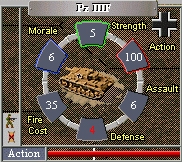
Game Statistics

|
| Victory Points |
Armour | Start | Start | End | End | ||
| Front | Side | Rear | Month | Year | Month | Year | |
| 3 | 4 | 3 | 2 | 9 | 39 | 2 | 41 |
| PzKpfw IIIF Medium Tank | ||||||||||||||||||||
| RANGE | 1 | 2 | 3 | 4 | 5 | 6 | 7 | 8 | 9 | 10 | 11 | 12 | 13 | 14 | 15 | 16 | 17 | 18 | 19 | 20 |
| HARD | 6 | 5 | 4 | . | . | . | . | . | . | . | . | . | . | . | . | . | . | . | . | . |
| SOFT | 5 | 4 | 3 | 2 | 1 | 1 | . | . | . | . | . | . | . | . | . | . | . | . | . | . |
History
|
|
|
Specification |
|
Basically the Ausf F was the same vehicle as the Ausf E.In fact it was the result of an order to mass-produce an effective battle tank.In January 1939 the order was reduced by 250 , after production orders had been placed for the improved models , Ausf G and H.The basic change was to the ignition system.Early in the production run cast air-intakes were added to the upper hull plate to allow air circulation for brakes and final-drive cooling.The majority were produced mounting the 37mm KwK , but approximately 100 were equipped with the 50mm KwK L/42 and external mantlet as original equipment.From August 1940 until 1942 many of the remainder were converted from the 37mm KwK to the 50mm KwK L/42 and external gun mantlet.Orders were also issued to up-armour the hull and superstructure by adding 30mm plates at the same time as the up gunning took place. |